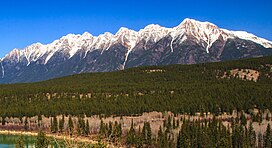The Steeples
 From Wikipedia the free encyclopedia
From Wikipedia the free encyclopedia
| The Steeples | |
|---|---|
 The Steeples | |
| Highest point | |
| Elevation | 2,804 m (9,199 ft)[1] |
| Prominence | 609 m (1,998 ft)[1] |
| Parent peak | Mount Fisher (2843 m)[1] |
| Listing | Mountains of British Columbia |
| Coordinates | 49°33′54″N 115°25′20″W / 49.56500°N 115.42222°W[2] |
| Geography | |
| Location | British Columbia, Canada |
| District | Kootenay Land District |
| Parent range | Hughes Range Canadian Rockies |
| Topo map | NTS 82G11 Fernie[2] |
| Climbing | |
| Easiest route | Scrambling |
The Steeples is a 2,843-metre (9,327-foot) elevation mountain ridge located at the southern end of the Hughes Range in the Canadian Rockies of British Columbia, Canada. Situated immediately east of Norbury Lake Provincial Park and the Rocky Mountain Trench, this prominent five kilometres in length ridge is visible from the Crowsnest Highway and Cranbrook. The nearest higher peak is Mount Fisher, 10.0 km (6.2 mi) to the north-northwest.[1]
History[edit]
The Steeples was named in August 1858 by Thomas Blakiston of the Palliser Expedition as presumably it was believed to resemble church steeples.[3]
The mountain's toponym was officially adopted in 1950 when approved by the Geographical Names Board of Canada.[2][4]
Climate[edit]
Based on the Köppen climate classification, The Steeples has a subarctic climate with cold, snowy winters, and mild summers.[5] Winter temperatures can drop below −20 °C with wind chill factors below −30 °C. Precipitation runoff from the mountain drains into tributaries of the Kootenay River.
See also[edit]
References[edit]
- ^ a b c d "The Steeples". Bivouac.com. Retrieved 2019-02-22.
- ^ a b c "The Steeples". Geographical Names Data Base. Natural Resources Canada. Retrieved 2019-02-22.
- ^ "The Steeples". cdnrockiesdatabases.ca. Retrieved 2021-06-18.
- ^ "The Steeples". BC Geographical Names. Retrieved 2021-06-18.
- ^ Peel, M. C.; Finlayson, B. L. & McMahon, T. A. (2007). "Updated world map of the Köppen−Geiger climate classification". Hydrol. Earth Syst. Sci. 11: 1633–1644. ISSN 1027-5606.
Gallery[edit]
External links[edit]
- Weather forecast: The Steeples



